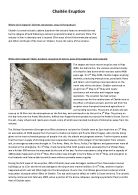Volcanic Case Studies
Introduction
Globally the risk of death or injury due to volcanic hazards are very small. However volcanoes attract disproportionate interest and are the first hazard to be considered in detail for this module.
Current population trends and economic necessity mean that an increasing number of people live close to volcanoes. The flanks of volcanically active mountains are often densely settled due to their fertile volcanic soil which is rich in potassium. This is particularly the case in the tropics where soil fertility declines quickly as intense rainfall causes leaching. For some nations, notably island states, volcanic soils are the only rich soils available. For example in Indonesia population densities are positively correlated with maps of volcanic activity.
As with all hazards there are natural and human components to their occurrence and aftermath. It is the interaction between society, technology and natural processes that this course module seeks to explore.
Two case studies will be considered in detail, the eruption of Nyriragongo in January 2002 in the Democratic Republic of Congo and that of Mount Pinatubo in 1991 in the Philippines.
Introduction
Globally the risk of death or injury due to volcanic hazards are very small. However volcanoes attract disproportionate interest and are the first hazard to be considered in detail for this module.
Current population trends and economic necessity mean that an increasing number of people live close to volcanoes. The flanks of volcanically active mountains are often densely settled due to their fertile volcanic soil which is rich in potassium. This is particularly the case in the tropics where soil fertility declines quickly as intense rainfall causes leaching. For some nations, notably island states, volcanic soils are the only rich soils available. For example in Indonesia population densities are positively correlated with maps of volcanic activity.
As with all hazards there are natural and human components to their occurrence and aftermath. It is the interaction between society, technology and natural processes that this course module seeks to explore.
Two case studies will be considered in detail, the eruption of Nyriragongo in January 2002 in the Democratic Republic of Congo and that of Mount Pinatubo in 1991 in the Philippines.







